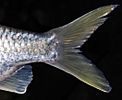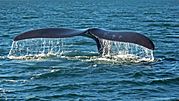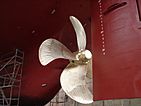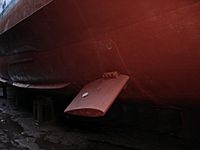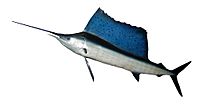Fin facts for kids
A fin is a flat part that helps things move or steer in water, air, or other liquids. Think of it like a paddle or a wing!
The word "fin" first described the body parts of fish. But now, we use it for other animal parts and even for things people make.
Fish have different kinds of fins, each with a special job:
- Dorsal fin: This fin is on the fish's back. It helps the fish stay steady and not roll over.
- Caudal fin (or tail fin): This is the main fin for pushing the fish forward through the water.
- Pectoral fins: These are paired fins, like arms, on the sides of the fish. They help with steering.
- Pelvic fins: These are also paired fins, usually on the belly. They help the fish move around and maneuver.
- Anal fin: This fin is on the underside, near the tail. It also helps with stability.
Fins usually work like special shapes called "foils." They create a pushing force (called lift or thrust) or help with steering and keeping things stable while moving. Fins can also be used to help cool things down or just for decoration.
Contents
How Fins Help Things Move
Fins shaped like foils create a pushing force when they move. This force pushes water or air, and the fin moves in the opposite direction. Many water animals get a lot of power by moving their fins back and forth. Often, they use their tail fin, but some animals use their pectoral fins to move. Fins can also create thrust if they spin in air or water.
Turbines and propellers use many spinning fins, also called blades. Propellers use these fins to turn a twisting force into a forward push, moving an airplane or ship. Turbines work the other way around: they use the push of moving gas or water on their blades to create power.
Sometimes, when fins move very fast, tiny bubbles can form in the water and then burst. This is called cavitation. It can damage the fins or make them less powerful. This can happen to boat propellers and even to fast-swimming animals like dolphins and tuna. Dolphins might slow down to avoid the pain of these bursting bubbles on their tails. Tuna don't feel the bubbles because their fins are bony, but the bubbles still create a vapor film that limits their speed.
Fish like tuna and mackerel are very fast swimmers. They have small, stiff fins called finlets along their back, near their tail. Scientists believe these finlets help the water flow smoothly around the tail, which might give the fish more push.
Fish use many fins, and sometimes one fin can affect how another fin works. For example, the fins just in front of the tail fin can change how water moves around the tail fin. Researchers have used special cameras to see how water swirls around swimming fish. They found that when a fish's tail moves, it creates swirling water patterns that help push it forward. The fins on the back and belly also help guide these water patterns.
Controlling Movement with Fins

Once something is moving, other fins can help control its direction and stability. Boats use fin-like rudders to steer and stabilizer fins or keels to reduce rolling. Airplanes use small, specialized fins on their wings and tail to change direction and keep steady.
Still fins are used on arrows and some darts to help them fly straight. They are also found on the back of bombs, missiles, rockets, and torpedoes to keep them stable. These fins are usually flat, like small wings, but sometimes they are shaped like grids.
Fins for Temperature Control
In engineering, fins are also used to control temperature. They are called heat transfer fins and are found in heat sinks (like in computers) or radiators.
Other Uses and Decoration
In nature, fins can also be used for showing off! For example, during courtship, the female cichlid fish, Pelvicachromis taeniatus, shows off a large, bright purple pelvic fin. Researchers found that male cichlids really liked females with bigger pelvic fins.
People also use fins! Swim fins, worn on human feet, help swimmers and divers move faster and more easily in the water, much like a fish's tail. Surfboard fins help surfers steer and control their boards. Modern surfboards often have a main fin and two side fins.
Fish that live in coral reefs often have different body shapes than fish that live in the open ocean. Open ocean fish are usually built for speed, like torpedoes, to glide through the water. Reef fish need to be able to dart and change direction quickly to navigate the complex coral reefs. Their fins, especially their pectoral and pelvic fins, have changed to help them stop quickly and make sharp turns. Many reef fish, like butterflyfish and angelfish, have flat, deep bodies that help them squeeze into cracks in the reef. Some fish, like puffer fish and trunkfish, mostly use their pectoral fins to swim and hardly use their tail fins at all.
Images for kids
-
Caudal fin of a great white shark
-
The ancient reptile Ichthyosaurus developed fins (or flippers) similar to fish
-
A robotic catfish called Charlie was built to test unmanned underwater vehicles


